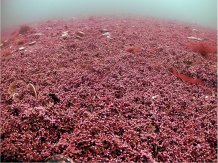Articles
Articles

Maerl in the Fal Estuary. Credit Mark Milburn, Atlantic Scuba
Scientists discover unique Cornish 'falgae'
Red algae that grow in Cornwall's Fal Estuary are genetically unique, new research shows.
University of Exeter scientists studied the population genetics of Phymatolithon calcareum, a coralline red algal species that forms maerl beds in shallow coastal seas from Portugal to Norway.
Large maerl beds fulfil a similar role to tropical coral reefs, providing habitats and vital shelter for hundreds or even thousands of fish and invertebrates. These algae also play an important role in storing carbon.
The findings reveal genetic differences are "structured geographically", with slight variations between populations sampled from across this large geographic area.
However, maerl in the Fal Estuary were found to be "genetically distinct from all other sites" – including at the Manacles reef, just 13 km away across Falmouth Bay.
Maerl-forming species are extremely slow-growing algae and some maerl beds are estimated to be thousands of years old.
However, they are threatened by shipping, dredging, agricultural pollution and climate change, and the researchers say their findings highlight the need for site-by-site conservation management.
"It appears that the unique diversity in the Fal Estuary has likely been shaped over time by geographical isolation of this maerl bed and a lack of genetic exchange with other P. calcareum populations," said Dr Tom Jenkins, of the University of Exeter.
"The wider genetic differences we found across north-east Atlantic are probably explained by the low dispersal capacity of this species, which limits connectivity between particular populations separated by large distances."
Speaking about the Fal Estuary, Dr Jamie Stevens added: "This is a busy waterway and is heavily used by commercial and naval shipping accessing Falmouth port.
"Consequently, in addition to agricultural run-off and so-called ‘grey water’ being carried by rivers and streams emptying into the estuary, the genetically unique Fal maerl bed is also at risk from marine pollution and the potential threat of sedimentation from dredging which has been undertaken periodically to maintain navigable access to the port.
"There are several large maerl beds around the coast of south and south-west England, and the genetic differences we identified show that these need to be managed on a site-by-site basis, as separate and distinct populations."
This study was funded by a British Ecological Society Research Grant.
The paper, published in the journal Evolutionary Applications, is entitled: "Whole genome genotyping reveals discrete genetic diversity in north-east Atlantic maerl beds."
Date: 31 March 2021
